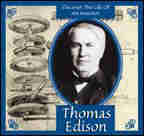
.Aula Máxima es la biblioteca y también lugar de recreo del espíritu. - José Vasconcelos

 |
.Aula Máxima es la biblioteca y también lugar de recreo del espíritu. - José Vasconcelos |
 |
|
SOL 79 Contents:
1. Small Business Administration's new Spanish-language site serves 80 pages of content SBA LAUNCHES NEW SPANISH-LANGUAGE
WEB SITE FOR SMALL BUSINESSES 2. Easy on the eyes: Virginia Woolf Foundation Some of you eagle-eyed youngsters may not have thought too hard about this, but: vision loss is usually gradual. Which means that when the letters in large-print books get too small, a person can either a) switch to audio books, b) learn Braille, or c) find even larger-print books. You've probably never heard of anyone doing c), but that's only
because you don't know Patricia Price of
Vision World Wide
or former attorney Mike Gold of the Virginia Woolf Foundation.
The VWF's inexpensive "Text-Key" publications present popular titles—from
Dickens to Twain to the Bible—in 30-point
and
even Coming soon from Text-Key are books from the Chicken Soup for the Soul and Harry Potter series; they're sure to be soothing and magical for readers relying on failing vision. Text-Key is also developing titles in Spanish, along with already-published bilingual glossaries for healthcare and library workers. Find out more, and see a demo, at the Text-Key website. And give Mike Gold a call. He'd really love to see more libraries set aside a fraction of an inch of shelf space for this big, beautiful format. 3. Here's how to survive your first solo story hour in Spanish You're terrified! The nightmares! You wake up in cold sweats, seeing little children huddled on the library's carpet, waiting for you to open your mouth and tell them stories in Spanish. Oh, sure—sounded like a great idea at the staff meeting. You knew there were lots of kids eager for it, so you spoke right up about this bilingual story hour inspiration of yours. You pumped out the publicity and now folks are ready for the program.. But suddenly your Spanish-speaking parent volunteers say they can't make it, and your bilingual teacher friend is busy that day. Over to you. And you've decided it's so complicated. You looked in a library magazine where some expert said some Spanish-speaking kids from somewhere don't understand the past tense, or something. Then you went and chose a book by a Colombian author when your audience skews Mexican, so won't that inevitably mess everything up? What if you unwittingly say the wrong thing, violate a regional taboo, and then they laugh at your accent? Or if— Hey! Grab hold of yourself! Do what children's librarians have always done: tell yourself you're a kickass storyteller. Believe it. Let that be your first great story. It's one of those affirmations that makes itself partially true by dint of the self-assurance it gives you. Kids dig that. Our buddy Marie Kaneko has been telling stories in Spanish and English for years in the libraries of Commerce, CA. She wants you to see a reassuring online guide called Story Times for Librarians of Limited Spanish, which will put your fears to rest with practical tips. Marie also swears by a children's programming site created by Oralia Garza de Cortés and the Texas State Library. It features not just book lists but also craft projects, games, rhymes and songs in glorious accent-reducing RealAudio. If it's book lists you want, Marie's got those, too. The Bibliotecas Para La Gente list is divided into themes (family, friends, food, cats, dogs, jungle animals, forest critters, birds, bears, nighttime, and The Imagination), while that of the Rutgers library school focuses on award-winning English-language and bilingual titles. Unless you have the time and the money to pick your books off a list, you'll be scoping out your own children's section for likely prospects. Go with what you like and feel you can confidently manage. Practice with the book till you're at ease; this is why bathroom mirrors were invented, and tape recorders. Before you go getting too nervous, though, remind yourself of the purpose behind all this. You are not the star of this show: the book is the star. Reading is the star. And so what if the kids laugh at you? This is supposed to be entertainment. You think George Lopez sits around worrying about why people are laughing at him? I think not. Finally, you can develop your ear for rhythm, intonation, and pronunciation by studying the wonderful StoryPlace site. Crank up the audio and then follow along with the cartoons and the corresponding printed text. Try mimicking the narrator's voice. This web project is a valuable companion to help you understand how a well-told story in Spanish should sound. 4. The globalization of the reference desk What what about the folks who wander up to the reference desk, asking questions in Spanish, only to be answered with a cheery shrug and "Noh cumprendooh, sorry." Where do those people take their information needs? "Bring 'em to us," say a couple online Ask-a-Librarian reference services. "Estamos a sus órdenes." 24/7 Reference, based in Southern California, and Library Systems and Services, Inc. (LSSI) of Germantown, Maryland both recently launched Spanish-language interfaces with bilingual librarians behind the curtain. Though the demo pages are free for anyone to use, the idea is that your library will contract with them and plant a connection icon on your website. For more specifics about "Bibliotecario a su alcance" contact 24/7's Susan McGlamery; for the details on "Servicios de referencia en español," get hold of LSSI's Denise Shereff. 5. At last: information that really knows how to party In concert with the debut of their online reference service in Spanish, LSSI rolled out one of the most comprehensive and appealing Spanish-language link lists you've probably ever seen, and gave it the party-all-the-time name of ¡Fiesta Informativa! With more than thirty topic headings, supplementary subheadings, and brief annotations in Spanish, this is a great place to look if your library's pathfinders need some shoring up If you want still more—tens of thousands—of indexed sites in Spanish, go to the dmoz open directory. Or if you want a ready-made, simplified link list with instructions in Spanish for the new Internet user, remember Tu Bibliotecario Electrónico. 6. David Bacon photos document Mexican labor struggles
From: Lincoln Cushing lcushing@library.berkeley.edu
Sent: Thursday, September 26, 2002
Subject: New labor photo exhibit through
Institute of Industrial Relations, UC Berkeley
Please check out the third in our popular Labor Photo Exhibit
series: A reception and presentation will be held in Berkeley on Thursday, October 10, 2002, 5:30-7:30pm, with speakers to include Professor Harley Shaiken and the photographer. The exhibit and the reception are at the Center for Labor Research and Education/Institute for Labor and Employment, Director's Room, 2521 Channing Way, University of California, Berkeley, CA 94720. For more information, call Lincoln Cushing, Electronic Outreach Librarian, Institute of Industrial Relations Llibrary, at 510-642-1056. 7. The Críticas bestseller list Many's the time you've lamented the lack of definitive Spanish-language bestseller lists. We've noted how they appear and disappear, and even if you do find a timely ranking there's probably something missing. Amazon's top sellers list in its "En Español" section, for example, reflects only the titles of the small number of Spanish-language publishers and distributors who do business with the Big A. Críticas magazine, always eager to help, last month introduced its own top-ten list of bestselling books in Spanish in the U.S. The sales data come from independent and chain bookstores and distributors. We don't know which ones, or how they're weighted, but Críticas promises to update the list monthly. 8. This book giveaway is rocket science, sort of Our friends at Rourke Publishing in Vero
Beach, Florida
produce handsome, sturdy books for young readers. Their series
on famous inventors has a volume devoted to screen idol Hedy Lamar,
who knew her way around a schematic diagram and developed an idea for
radio frequency-hopping that is used in the satellite relays of
today's Internet. Vero
Beach, Florida
produce handsome, sturdy books for young readers. Their series
on famous inventors has a volume devoted to screen idol Hedy Lamar,
who knew her way around a schematic diagram and developed an idea for
radio frequency-hopping that is used in the satellite relays of
today's Internet.
The series is one of Rourke's Spanish-language offerings, and it's the prize in this issue's contest. Six volumes, hardbound, reading level 3, grade interest level 1 - 4, library price $77.70. Shipped to you—yes, you, who haven't won one of these sets from us before—free of charge if you turn out to be the first person to send the correct answer to this question:Who was the first Mexican to orbit the earth, and what state is s/he from? When you know the answer, send it into orbit quickly! The kids are counting on you!9. Reading Steinbeck in Spanish As soon as the California Center for the Book decided to celebrate the centennial of John Steinbeck's birth (Feb. 27, 1902) by inviting us all to read The Grapes of Wrath for its one-whole-state-reads-the-same-thing thing, it took steps to make sure the book would be available in Spanish. No translation was in print, but by now Las uvas de la ira, in a 2002 Penguin USA edition, is owned by libraries all over California. Was the CCB's effort worthwhile? If you have any doubts, read this Oct. 2 San Francisco Examiner story ("Savoring 'Grapes'," by Rachel Howard). An excerpt: Judy Iranyi-Stone agrees that almost any Californian can relate to Steinbeck. A retired social worker and native of Venezuela, she's reading the just-published Spanish language edition for her library book club. "Some people have said to me, 'In Spanish—why?' " she says. "But it relates very much to the Latino community. I think the experience Steinbeck describes in this book might have been specific to the Okies, but there's so many parallels to the immigrant experience and the Latino experience." She and several members of her book clubs—she's in three—plan to attend multiple readings and film screenings. "We're doing away with the stereotypes that Latinos don't read, that they're not educated, that Latinos are all the same," she says. 10. Publishers of Latino newspapers meet in D.C. The National Association of Hispanic Publications (NAHP) met with power brokers in the nation's capital at the end of September, and honored some of their own with awards for excellence in journalism. Who's the NAHP? It's a big organization of people like the ones who publish your local free Spanish-language periodicals. You know, the ones that report on and document the experiences of local Latino cultures. Those newspapers. The ones you probably don't shelve @ your library. NAHP and NHPF honor Latina Publisher and Latina Journalist of
the Year Bruce Jensen flaco@sol-plus.net
|
|
| |||||||||||||||||||||||||||||||||||